Aviation against tanks (part of 5)
Back in the years of World War II, attack aircraft pilots were faced with the fact that it was very difficult to achieve hits from cannons in a single tank. But at the same time, the speed of the IL-2 was about two times lower than that of the Su-25, which is considered to be a not-too-fast airplane with good conditions for attacking point ground targets. It is very difficult for an attack aircraft, and even more so for a supersonic fighter-bomber to get into the armored vehicles with unmanaged means of destruction, moving on the battlefield at a speed of 10-20 km / h. At the same time, the combat aircraft itself is exposed to a serious threat from the ZSU, short-range mobile air defense systems and MANPADS. The ideal option would be a variant of an armored low-speed attack aircraft capable of delivering pinpoint strikes. weaponsbut it was never implemented.
In 60-s in different countries, including the USSR, the development of guided anti-tank missiles. At first, very imperfect anti-tank guided missiles were guided in manual mode by wire or radio channel. The task of the operator was to combine the rocket tracer with a moving target, which seemed a daunting task, required considerable training, and the percentage of misses was very large. Nevertheless, even in this case, the probability of hitting the target was significantly higher than when using unguided aircraft armaments — guns, NAR and free-fall bombs.
At the end of the 50 in the USSR, they began experimenting with the installation of weapons on the Mi-1 helicopter. Originally it was NAR TRS-132. Six tubular rails for ORO-132 missiles were mounted onboard. Then came the options, armed with machine gun rifle caliber and holders for bombs weighing up to 100 kg.
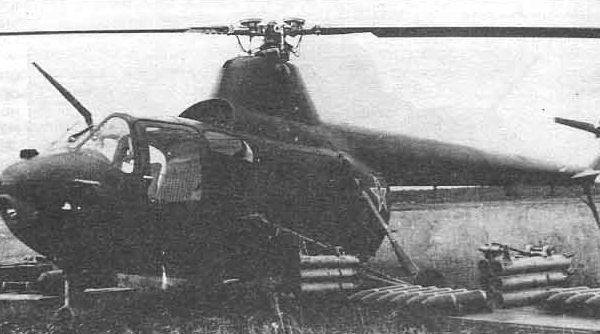
It is clear that a helicopter with such armament could not represent a serious threat to enemy armored vehicles, and even with the maximum flight speed of 160 km / h and the absence of a reservation, it was a very easy target. In this regard, the designers decided to equip the helicopter anti-tank missile system. At that moment, the Phalanga and 2K8 “Baby” ATGMs 9K11 “Phalanx” were considered the most promising models.
Anti-tank complex "Phalanx" provided defeat targets at a distance of 2,5 km, with a minimum range of 500 meters. The flight speed of a rocket with a launch weight of about 28 kg was 150 m / s. Guidance missiles carried by radio. In the tail of the rocket two tracer were mounted. When meeting at an angle of 90 °, the seven-kilogram cumulative warhead pierced 500 mm in homogeneous armor.
ATTM 9K11 “Baby” had lighter 10,9 kg missiles with a launch range of up to 3000 m. The combat part of the ATGM weighing 2,6 kg penetrated the normal 400 mm armor. Guidance "Baby" was carried out by wire. Rocket speed - 120 m / s. In general, compared to the Phalanga, it was a much simpler and cheaper complex, but its data were too low for use from a helicopter. However, the Mi-1, equipped with the six “Baby” ATGM, was presented for testing.
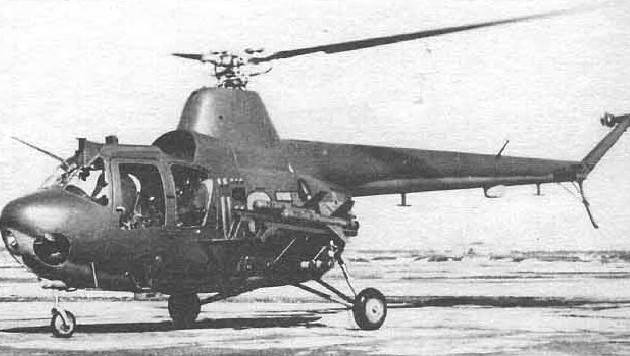
Shortly after the adoption of the "Phalanx" in service, a modernized Phalanga-M ATGM with semi-automatic targeting appeared. After the launch, the operator was enough to hold the target in the crosshair of the reticle, and the guidance commands were automatically developed and issued by the control equipment. In the modernized complex, the preparation time for launch was reduced, thanks to the use of more powerful engines in the ATGM, the launch range increased to 4000 m and the rocket speed to 230 m / s. At the same time, the probability of damage in good visibility conditions was 0,7-0,8.
In 1962, the Mi-1МU as a whole was successfully tested, but by the time they were completed, the serial production of the helicopter had already been turned off. In addition, the generals, who did not understand the advantages of a helicopter with guided anti-tank missiles, were skeptical about the combat capabilities of light dragonfly-like machines. In this regard, Mi-1U remained experienced.
Almost simultaneously with the Mi-1 armament, the development of the Mi-4 helicopter was launched. Initially, the Mi-4AB armament consisted of holders for NAR UB-16 blocks or bombs. Later on the "four" tested ATGM "phalanx".
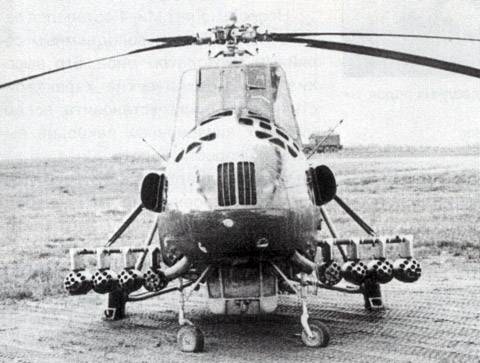
However, as in the case of the Mi-1, the military was not in a hurry to adopt attack helicopters. Only in 1966, after the decision to develop the transport-impact Mi-24A was made, an order was issued for the Mi-4AB helicopter gunships.
The helicopter’s armament includes four 9М17М Phalang-M ATGMs and three girder holders for six UB-16 units with sixteen NAR C-5 in each or six 100 kg of bombs. Also four 250 kg bombs or two incendiary tanks of BZ-500 could be suspended. A large-caliber 12,7-mm machine gun A-12,7 was mounted in the ventral gondola.
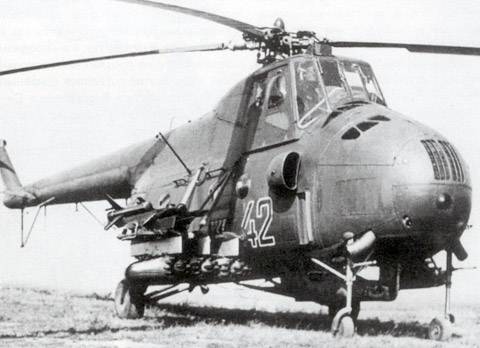
ATGM was at the disposal of the navigator, who carried out the launch and guidance of guided anti-tank missiles. The dropping of bombs and the use of NAR was made by the crew commander who was in control of the helicopter, and the fire was conducted by a flight engineer.
Although the Mi-4AB with a piston engine ASH-82B power 1250 hp did not have armor and could develop the entire 170 km / h, it was quite combat-ready machine. In addition to armament, the helicopter could take on board the 8 paratroopers with personal weapons. In total, about two hundred "fours" were converted to the Mi-4AB version.
For the first time, anti-tank Mi-4AVs were used in battle in the Doomsday War. Despite the modest flight performance and high vulnerability of the Quartet, the armed ATGMs during the battles on the Sinai Peninsula on October 8 and 9, 1973, made more than 30 sorties. It is believed that on their account there are destroyed Tanks from the Israeli 162nd Armored Division.
In general, the first experience of equipping Mi-4 helicopters with anti-tank weapons was positive. At the same time, it became absolutely clear that in order to increase combat effectiveness in modern conditions, a special development machine is needed, having a reservation for the cockpit and the most vulnerable components and assemblies, as well as special aiming and navigation equipment associated with the weapon system.
At the end of 50-x, it became clear that the Mi-1 helicopter is rapidly becoming obsolete and needs replacing. The main problem that arose during the creation of the new helicopter was the lack of a relatively lightweight and economical gas turbine engine in the USSR. Especially for the Mi-2 helicopter in the OKB-117 under the guidance of S.P. Izotov was created engine GTD-350 with power 400 hp When designing the Mi-2, a number of piston Mi-1 units were used. Such an approach significantly accelerated the introduction into mass production of a new light helicopter. The first flight of the prototype took place in September 1961. But the fine-tuning and testing of the helicopter with still raw engines was delayed until the 1967 year.
The helicopter, equipped with a pair of GTD-350 engines, had a maximum take-off weight of 3660 kg and a passenger capacity of 10 people. Maximum speed 210 km / h. Practical range without additional fuel tanks 580 km. In general, the machine in its characteristics corresponded to foreign classmates. The complaints only caused a relatively high fuel consumption of engines GTD-350.
From the very beginning, the military showed great interest in the Mi-2. In the future, in addition to reconnaissance, coherent and sanitary options, it was planned to create a light anti-tank helicopter. But by the time the helicopter was ready for serial production, it turned out that its concept did not fully meet modern requirements. The ideas about the role and place of the light helicopter, formulated by 50-s and designed in the form of a technical task, were outdated by the time Mi-2 appeared. The desire to preserve the dimensions of the piston Mi-1 imposed serious constraints at the design stage. From the Mi-2 it was not possible to create the Soviet Iroquois - it was not able to take on board a detachment of soldiers or the corresponding cargo. The efficiency, payload and maneuverability of the Mi-2 for a helicopter of this class left much to be desired. Experts in the end of 60-x said that different light helicopters of the new generation are needed - one should be the Mi-4 class, the second was seen as quite small, with a passenger capacity of 2-3. However, the drawbacks of the Mi-2 are not so much the fault of the designers who did everything to improve the car, as errors at the level of formulating the very concept of the helicopter and the lack of a lightweight gas turbine engine with high technical characteristics in the USSR.
In 1966, the combat Mi-2В was developed with 4 UB-16 units or with the same number of Phalang-M ATGM. However, delaying the tests of the base helicopter led to the fact that the strike version was able to bring to an acceptable level only at the beginning of the 70-x. By that time, the serial construction of the transport and combat Mi-8TV was under way and the Mi-24А was on its way.
The loss of military interest was also due to the fact that the construction of the Mi-2 was transferred to Poland. Its production was established at the helicopter plant in the town of Svidnik. The production of GTD-350 engines was entrusted to an enterprise in Rzeszow. The Poles got the right through 10 years after the start of serial construction of the Mi-2 to make independent changes to the basic design and create their own versions of the helicopter.
The Vietnam War fueled interest in light helicopters equipped with gun-gun and missile weapons. In June, the 1970 of the year in Poland began testing the Mi-2 with the 23-mm NS-23 cannon mounted on the port side and two 7,62-mm PKT machine guns on the starboard. In addition, on the pivot installations in the windows of the cargo compartment were mounted PKK light machine guns, the fire from which was led by a flight engineer. This variant, designated Mi-XNUMHUS, was built in a small series. Following the Mi-XNUMHUS, the Mi-2URN appeared. The helicopter's armament was reinforced with 2-mm NAR units.
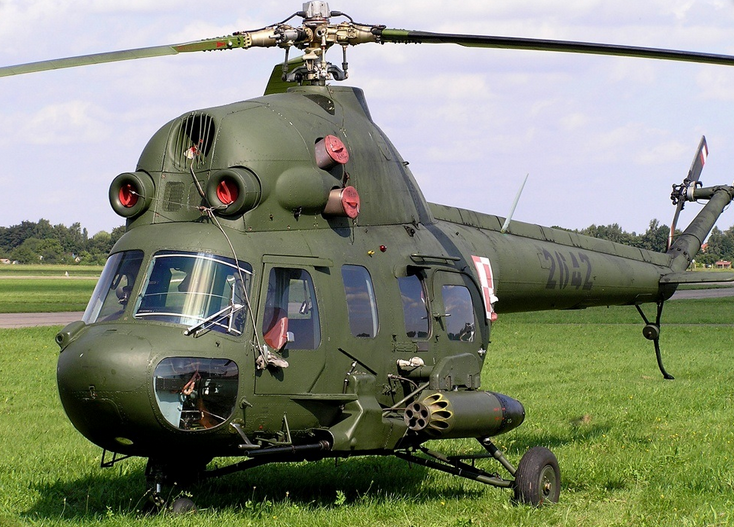
In 1972, the Mi-2URP was passed to the tests with attachment points for four “Malyutka” ATGMs. The operator’s workplace with a telescopic sight and pointing console was located next to the pilot. Although the stated range of the launch of the “Malyutka” ATGM was 3000 m, with the launches at the range 2000 m, it was possible to achieve hits in a shield target imitating a tank, a little more than half the time. The reason for the low accuracy of firing of wire-guided missiles was the vibration of the helicopter, as well as the imperfection of the guidance system, designed to launch missiles from a fixed platform. Nevertheless, the helicopter was put into service, and it was built in series.
Due to the low combat performance and low security, the armed versions of the Mi-2 did not interest the Soviet commanders. But this did not prevent deliveries to other Warsaw Pact countries. Thus, Polish experts were able to realize what was abandoned in the USSR. The Mil Design Bureau at the beginning of the 70-x was overloaded with orders, and the military light anti-tank helicopter was not interesting. Mi-2, be it equipped with more powerful engines and long-range ATGM with a semi-automatic guidance system, could be quite good in the role of a light inexpensive combat helicopter.
In 1960, the development of a medium transport helicopter with gas turbine engines began; in the future, this machine was to replace the Mi-4 piston. The serial construction of the helicopter, designated Mi-8, began in the first half of 1965 at the aircraft factory in Kazan. In 1969, the Mi-8 was completely replaced in the production of the Mi-4. For its time, the Mi-8 was an outstanding machine, with very good flight performance, advanced equipment and high modernization potential. This predetermined the long life of the helicopter, built in large batches and the creation of numerous modifications.
Mi-8T helicopter, equipped with two TV2-117 engines, power 1500 hp each developed a maximum speed of 250 km / h. With a maximum take-off mass of 12 000 kg, the helicopter could transport cargo weighing 4000 kg and had a practical flight range of 450 km.
On the basis of the transport amphibious Mi-8T in 1968, an armed modification of the Mi-8TV was created. The G8 armament set was previously tested on the Mi-4AB. Transport and combat Mi-8TV, presented to the test, received a lighter and cheaper anti-tank "Malyutka" with a smaller launch range. Also provided for the suspension of blocks of NAR and bombs weighing up to 1500 kg.
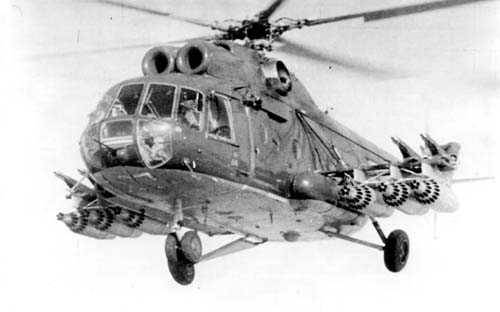
Compared to the Mi-4AV, the caliber of the bombs used has increased significantly. These could be bombs weighing 100, 250 and 500 kg, including one-time bomb cassettes equipped with PTAB. Thus, the helicopter’s shock potential was not inferior to the MiG-21 fighter and against tanks, in addition to the ATGM, the NAR C-5K / KO with a cumulative warhead and PTB in RBC-250 and RBC-500 could be used.
The conditions for searching for targets and targeting weapons on a helicopter were generally better than on a fighter-bomber. But at the same time, the pilot who launched the NAR, and the navigator who directed anti-tank guided missiles, had to rely only on his own vision when searching for targets. The combat value of a fairly large helicopter was reduced by the fact that the "eight" with an anti-tank missile system was very vulnerable to anti-aircraft systems and fighter jets. Due to the significant weight of such a method of using an anti-tank guided missile system, such as the hanging of a helicopter and shooting with the use of terrain folds, it proved difficult to implement.
The first anti-tank modification of the G8 had solid armor protection. The cockpit from bullets and fragments covered removable armor plates with a thickness of 8 mm. Armor was also mounted in the bulkhead from the cargo compartment. The pilot and navigator seats were armored and armored. A part of the cabin glazing was made of transparent armor 50 mm thick. The fuel pumps and hydraulic units of the control system were partially booked. The fuel tanks were designed.
Initially, the A-8 machine gun with 12,7 ammunition ammunition was introduced into the Mi-700TV armament. The installation of a large-caliber machine gun cluttered the cockpit heavily. Due to the lack of space, the ammunition unit had to be placed in the cartridge case on the front wall of the cargo hold, and the tape was pulled along the outer sleeve. However, this was subsequently abandoned, replacing the A-12,7 with a PC rifle-caliber machine gun. For firing at armored vehicles, the 12,7-mm machine gun was weak, and when used in manpower it had no advantages over the 7,62-mm machine gun. In addition, the use of machine-gun weapons in the fighting was episodic in nature, and it was considered rational to carry dead cargo in the form of a machine-gun unit with an ammunition weight of about 130 kg. When firing from the A-12,7, approximately after the 100 shots, due to the high gas content in the cockpit, there was nothing to breathe. In general, the large-caliber machine gun was not popular with helicopter crews, and flew, as a rule, without it.
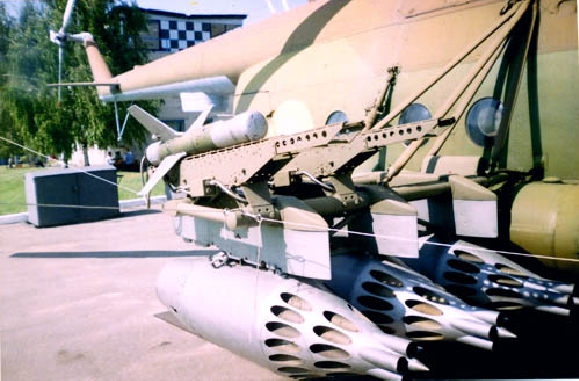
In 1974, the Mi-8TV equipped the Phalanga-M ATGM with the Rainbow-F guidance system, which was more suitable for use from a combat helicopter. As a result, the transport and shock Mi-8TV, intended for its own army aviation, Mi-8TB with ATGM "Baby" was delivered to the allies.
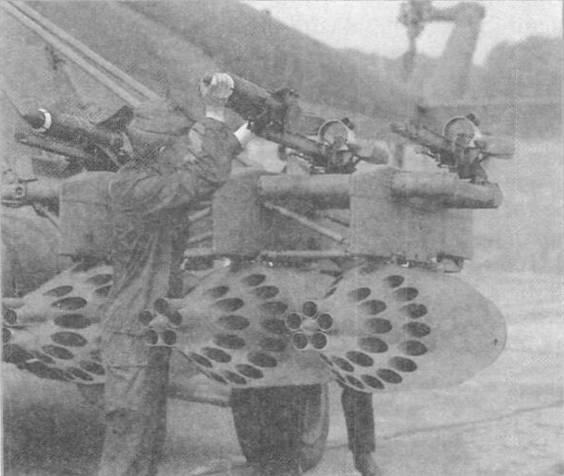
Mi-8TV helicopters were built relatively little, because of similar weapons, they were most often used in the regiments where there were Mi-24. The reason for the limited edition of the Mi-8TV was the fact that, due to the large mass of weapons and armor, the flight data deteriorated significantly, and the payload and flight range decreased. The cockpit was overly cluttered with weapons, an ATGM guidance system and other sighting equipment. So, for the use of various weapons in the cockpit there were four sights. As a result, starting from the end of the 70-x, units with large-caliber machine guns and bulky ATGM guidance equipment were gradually dismantled in the front-line shelves. This made it possible to reduce the flight weight of helicopters, which had a positive effect on flight data, improve the working conditions of the crew and concentrate on the direct functions of delivering cargo and paratroopers, and, if necessary, provide fire support to ground units.
In the future, the use of guided weapons on the Mi-8MT / MTV versions with more powerful TV3-117MT and TV3-117ВМ engines was abandoned for some time, concentrating on increasing the load capacity, reliability, range and dynamic ceiling. However, small arms, external nodes of the NAR and bombs on the "eight" are preserved.
In 2009, in Russia, the transport and impact Mi-8AMTSH (export designation Mi-171Ш) was adopted. The helicopter uses two turboshaft engines TV3-117ВМ with take-off power 2100 hp, on upgraded Mi-8АМТШ-В, which went to the troops since summer 2014 of the year, two VK-2500-03 with improved transmission.
The armor protection of the helicopter is enhanced by lightweight ceramic-metal armor. The helicopter received a new avionics complex, which, among other things, includes meteorological equipment, pilot night vision goggles, a thermal imager and satellite navigation equipment. Due to this Mi-8AMTSH has the ability to act at night.
Basic variant arms Ni-8AMTSH includes 20-minute charging units 80-mm NAR C-8 and suspended containers 23-mm cannon GSH-23L on 4-6 beam holders and two 7,62-mm machine gun PKT in the bow and stern units . If necessary, the helicopter can be armed with the Sturm-V complex with 9М114 or 9М120 guided missiles. This allows relatively inexpensive to turn a transport-combat helicopter into an anti-tank. What can be interesting to countries where there are Mi-8 / 17, but there are no specialized combat helicopters.
To be continued ...
Based on:
http://www.razlib.ru/transport_i_aviacija/aviacija_i_vremja_1995_03/p3.php
http://авиару.рф/aviamuseum/aviatsiya/sssr/vertolety/vertolety-kb-milya/mnogotselevoj-vertolet-mi-1/legkij-udarnyj-vertolet-mi-1mu/
http://www.arms-expo.ru/armament/samples/1001/65179/
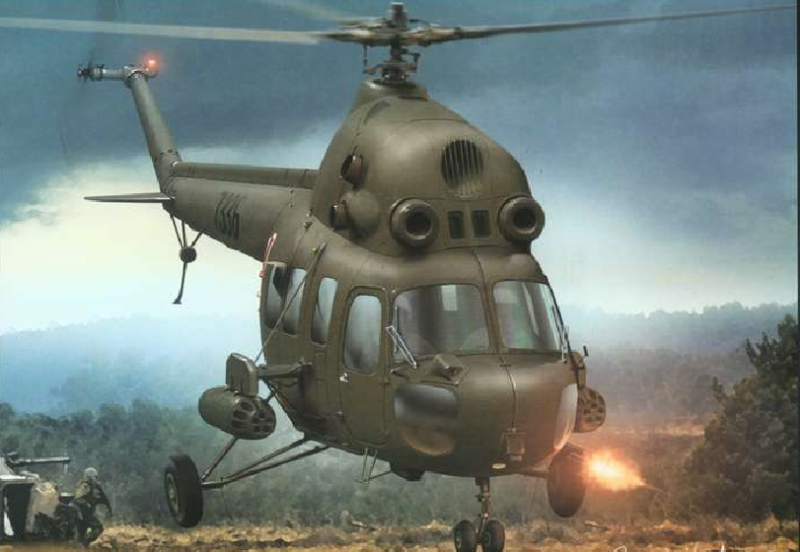
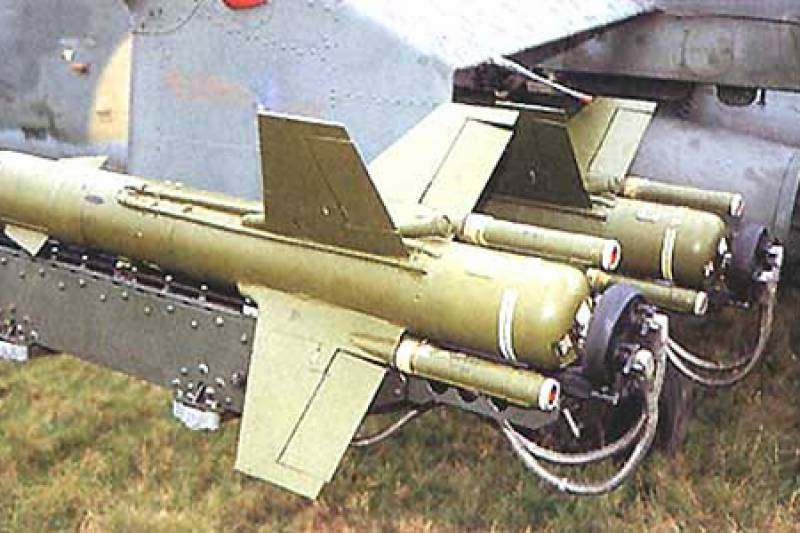
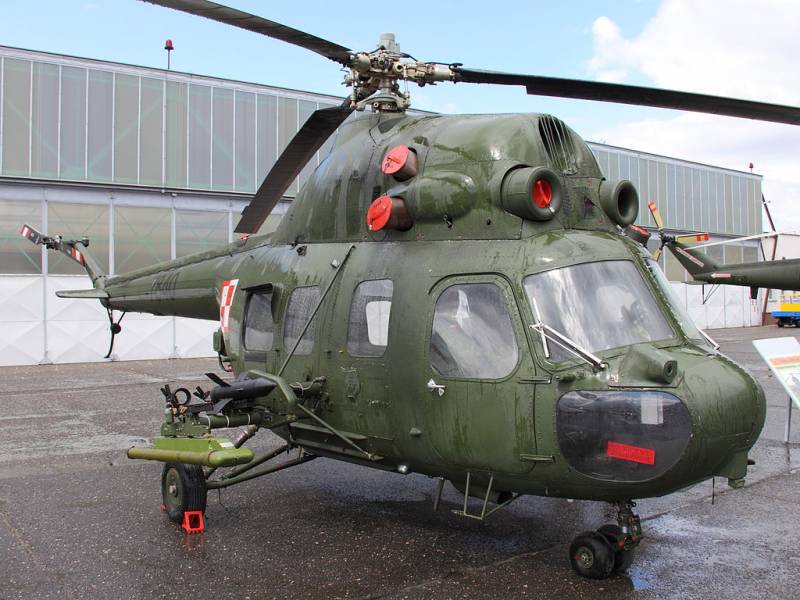
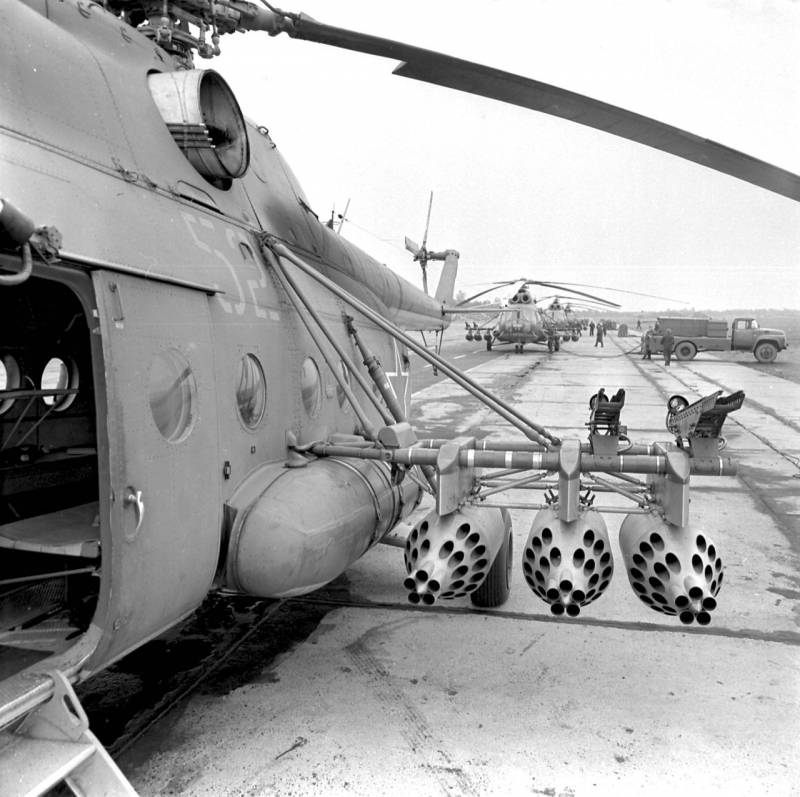
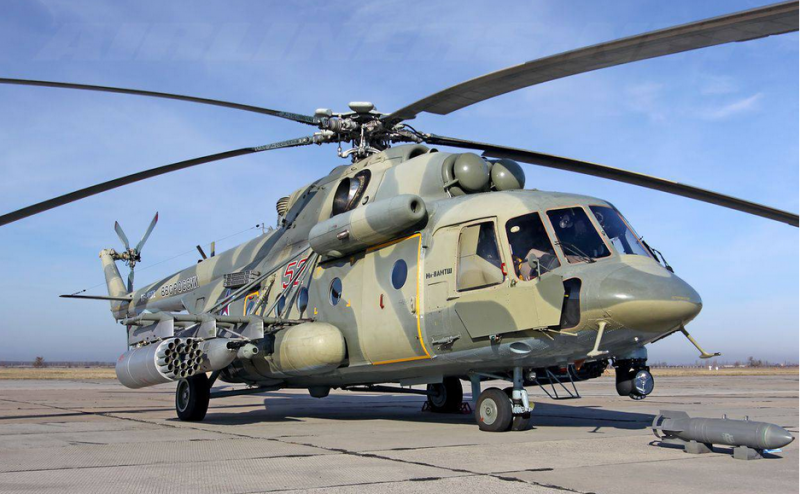
Information